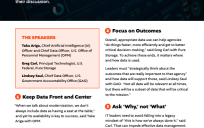Communication plays a pivotal role in safeguarding the public health and well-being of communities. It serves as the bridge between scientific knowledge and actionable information, helping individuals make informed decisions about their health. It is the linchpin that holds together our collective efforts to combat diseases, promote healthy behaviors, and ensure the well-being of our societies.

Today, we stand at the cusp of a transformative era in public health communication. Thanks to rapid advances in artificial intelligence (AI), tools such as generative and predictive AI are now accessible to a broad range of communications professionals. AI has the potential to drastically improve the efficiency and efficacy of public health communications. Specifically, it can transform how we disseminate information, engage with diverse populations, and leverage data for more targeted and efficient communication strategies — changing the game for both public health officials and their communities.
A Personalized Approach
AI gives public health officials the power to analyze vast amounts of data and identify data patterns to create personalized messages that resonate with priority populations. This capacity can provide valuable insights that can be used to inform communication messaging and engagement strategies. Likewise, they can be used to help public health agencies stay ahead of emerging trends and community concerns.
By continuously monitoring online conversations, news sources, and social media platforms, AI can identify shifts in public sentiment and sentiment trends, allowing for proactive messaging strategies tailored for specific audiences. This approach ensures that messages remain relevant, timely, and effective in addressing emerging needs.
Opportunities for Optimization
AI isn’t a magic wand. It is a collaborative tool able to help streamline processes. Many health agencies already use AI in various forms to help them automate tedious or repetitive tasks and work more efficiently.
For example, AI can be used to create public-facing chatbots that can address common questions, offer timely information on health measures, and even assist with appointment scheduling. Creating pathways for real-time engagement with the public can foster deeper trust, while ensuring timely information dissemination — all while improving the bandwidth of public health workers.
Content creation is another potential application of generative AI. These tools can be highly effective when developing communication campaigns. AI can help with concept ideation, writing, automation of materials production, as well as search engine and campaign optimization, empowering teams to create high-quality materials at an unprecedented speed. Using AI within concept and content creation enables communications professionals to focus on more complex and strategic aspects of their work, enhancing overall productivity.
While transformational in its potential, it’s important that public health leaders who are starting to use generative AI tools understand the limitations of AI-generated content. With generative AI platforms, the output it creates is only as good as the input a user provides. Using conversational thinking or query engineering to properly frame a question or request is key to generating usable results.
Even with proper prompts, leaders still need to lean on subject matter experts to conduct expert reviews of outputs to ensure accuracy and validity of communications. These reviews need to be critical and go beyond a simple right and wrong to consider context. Asking questions like “Is this message appropriate for the intended use? Does it strike the right tone?” and “Will the language be understandable for the intended audience?” are great places to start.
Mitigating Risks and Ensuring Ethical Use
While AI offers numerous benefits, public health agencies must remain vigilant about potential risks and ethical considerations. Addressing bias in AI-generated content and mitigating the risk of hallucination, where AI generates false information, is paramount.
Regular reviews and validation processes need to be established to ensure the accuracy and reliability of AI-generated content. The bottom line is that public health agencies who want to garner the benefits of AI will need to invest in training to ensure the staff understands the nuances of AI and how to use it effectively.
Safeguarding privacy and data security is non-negotiable. Public health leaders must also establish robust privacy protocols and adhere to relevant regulations to protect sensitive health information. Ethical considerations should be at the forefront of AI implementation, with transparency, accountability, and fairness prioritized in all AI applications. This can be provided through additional staff training on responsible AI use and decision-making.
Ultimately, public health leaders, data scientists, and communication experts must work together to unlock the full potential of AI. To ensure the effective integration of AI into communication initiatives, collaboration among multidisciplinary teams is crucial. Regular communication, knowledge sharing, and ongoing training among these disciplines are essential to maximize AI’s potential in informing, promoting, and safeguarding community health.
Mary Schwarz, Managing Partner, ICF Next Government, is a digital strategist and marketing technologist with a comprehensive range of experience in direct marketing, web development, community outreach, and analytics, Mary leads our Government, federal digital and engagement practices. She brings over 20 years of experience providing strategic guidance for health, education, and social programs.
Mary helps clients define their objectives and business goals; map user journeys; and develop incremental and iterative development plans. She also helps clients evaluate the impact and efficiency of their programs, and revise and optimize their digital programs for maximum impact.
Mary has extensive experience crafting data-driven digital and engagement programs using a combination of on- and off-line tactics and strategies. Her work often calls upon deep data analytics to not only inform and tailor experiences, but to drive timing, frequency, and lasting behavior change.





Leave a Reply
You must be logged in to post a comment.